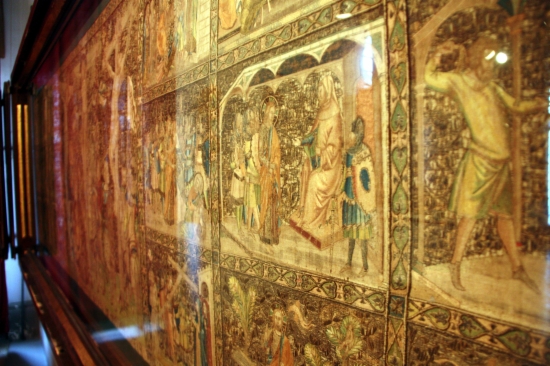Manresa's Cathedral to unveil unique Florentine altar frontal from mid-14th century
The History Museum of Manresa’s Cathedral (Central Catalonia), which was closed to the public until now, will reveal among its most valuable pieces a Florentine altar frontal dating back to the mid-14th century. Such a work is one of the world’s most unique frontals, considerably large, embroidered with gold thread and portraying key events in the life of Jesus Christ, with a specific focus laid on his crucifixion. Art Historian Sílvia Ruiz, said to the CNA that this piece is the “cathedral’s jewel” and explained that it was purchased by Catalan merchant Ramon Saera in 1357. Visitors will be able to discover the frontal and others of Manresa’s gems in special guided tours once a month.

Manresa (ACN).- The History Museum of Manresa’s Cathedral (Central Catalonia), which was closed to the public until now, will reveal among its most valuable pieces a Florentine altar frontal dating back to the mid-14th century. Such a work is one of the world’s most unique frontals, considerably large, embroidered with gold thread, and portraying key events in the life of Jesus Christ, with a specific focus laid on his crucifixion. Art Historian Sílvia Ruiz, said to the CNA that this piece is the “cathedral’s jewel” and explained that it had been purchased by Spanish merchant Ramon Saera in 1357. Visitors will be able to discover the frontal and others of Manresa’s gems in special guided tours once a month. This Catalan city is famous because it was where Saint Ignatius of Loyola had his mystical enlightenment. Above the cave where the founder of the Jesuits – to which Pope Francis belongs – was undertaking his Spiritual Exercises, a large Baroque-style monumental convent was built.
Manresa’s old cathedral, the iconic symbol of the city, will offer from now on a regular schedule for guided tours, which will be held on the second Saturday of each month. Visitors will first take a stroll outside the Romanesque-Gothic Cathedral and the Baptistery, then go inside and admire the crypt, and will most importantly get to venture in the museum, which was closed to the public until now and only opened when someone specifically asked for it, or for special events, for instance ‘Manresa Desconeguda’ visits (Manresa unknown).
Art Historian Silvia Ruiz, who is in charge of the guided tours, explained that the museum had reopened “because it has a very important collection and holds several pieces of historical and liturgical value”. The museum had opened in 1934 to preserve and exhibit works of sacred art, which were no longer in use, far from daily worship.
Among the most important pieces features a unique medieval altar frontal from Florence, signed by Geri di Lapo in Italy and acquired by Manresa Merchant Ramon Saera in 1357. According to Ruiz, it is the cathedral’s “jewel” with its gold-threaded embroidery, silk and linen. Interestingly, Ruiz explained that it was one of the very few existing signed frontals and stressed that the piece was a significant one due to its antiquity and good preservation.
Altarpieces, liturgical vestments and silverware among other pieces
In addition, visitors will for instance see a Romanesque crucifix with wood carvings dating from the 12th century. The piece was concealed in a baroque altar for centuries, and although it has undergone several modifications, its original carvings and colours are very much visible.
Among the pieces, are the ‘Arquetes dels Cossos Sants dels Patrons de la Ciutat de Manresa’ dating from 1616-1653, luxurious golden reliquaries created to cover the old wooden boxes protecting the ‘holy bodies’ of the patron saints of Manresa. One of them is dedicated to St. Maurice and the other one to St. Fruitós and St. Agnes. On the 31st of August, the day commemorating the arrival of the ‘holy bodies’ in the Basilica, the reliquaries are moved to the Cathedral for mass.
Among the museum’s other pieces, visitors can encounter fragments of Baroque altarpieces coming from Manresa workshop Grau i Sunyer, an altarpiece dedicated to Saint Pontius (dating from the 16th century), a representation of the Immaculate Conception ( 17th century); and numerous jewellery items and liturgical vestments .